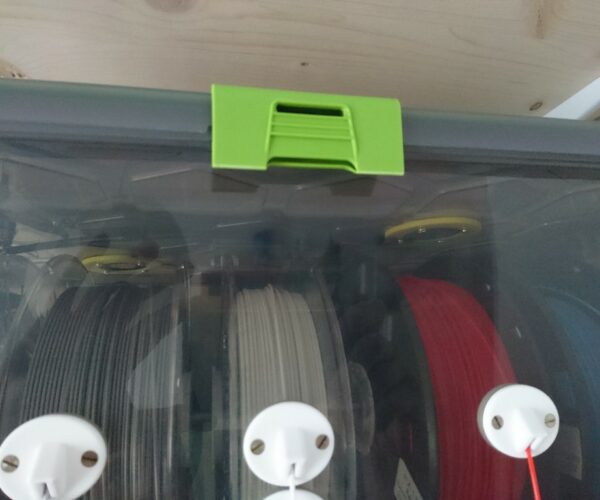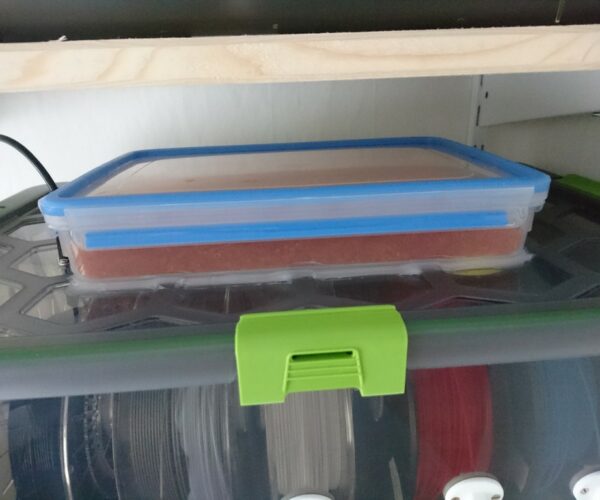Silica gel question
Hello,
I got two dryboxes and made some dryingtowers for them (fans that blow the air through silica gel). There are some DHT22 in each box that I read out over network and also some silica gel saturation sensors that are not completely functional yet (to get a value of 0 to 100% of how saturated the silica gel is over the network).
Now one of the towers gets down to 15% air humidity but the other one is stuck at about 30% humidity. I was wondering how far can humidity go down with silica gel? both are almost fresh gel. Is the minimum air humidity related to the saturation of the silica? I am not a chemist but how I understand silica it should work well until saturated.
Any thoughts on this topic? sorry if it doesnt belong but I didnt know where else to ask.
Thanks
Best regards
RE: Silica gel question
I am not a chemist either. But I am sure drying with silica gel is not enough to get the moisture out of all types of filament.
I use a food dryer to heat up the filament to get the moisture out - in the same way I use the heat dryer to dry the silica bags used with the filament to keep it dry.
Have a look at my models on Printables.com 😉
RE: Silica gel question
Unfortunately, you won't pull appreciable amounts of moisture out of any filament with just some silica gel hanging out nearby, even with a fan blowing. You need to use a dehydrator or printdry or something first to get the moisture out of the filament using low heat, and then silica gel is just to help maintain that and prevent moisture from getting back in by keeping your drybox air dry.
RE: Silica gel question
Ok, thanks for the replies.
Just for the storage, is 30% humidity ok? I read that it should be about 15% but that is quite low to acheive.
RE: Silica gel question
My filament storage goes down to 5%-10% humidity when I'm maintaining it well. The most important thing I learned is using enough silica gel for the container — think almost carpeting the floor of a tub with gel sacks.
Also, remember that silica gel may have very high capacity for moisture per volume, but it's still equilibrating with the atmosphere — not pumping moisture out — so that once it's hit equilibrium it won't get drier. Thus, to get the most out of a given volume of gel, you have to change it out for fresh ('recharged' i.e. baked dry) gel a few times. Then the limiting factor is how leaky the container is and how often you open it.
RE: Silica gel question
Its really strange. After having it in air tight boxes over just one night the humidity doesnt drop below 17 %. And that is with my blowers blowing the air through the silica. Could it be some low quality silica?
What exactly does equilibrium mean?
RE: Silica gel question
What exactly does equilibrium mean?
Water diffuses — it moves about in the air, and into and out of the silica gel, at random. If you put wetted silica gel into a container of dry air, the humidity would increase as water exits the gel. It's a mixing process — eventually things get into some more-mixed-up stable state, or equilibrium.
The reason silica gel is good for removing moisture from the air is because it has a much higher "capacity" for holding moisture, per volume, than air. So, when you put dry silica gel in a box, it's sort of like you connected that box to another really big box of dry air — eventually the humidity will even out between the two boxes. But this doesn't make the humidity in the small box zero. You can keep replacing the "big box" (silica gel container) with new dry ones and reduce the humidity further — this works because you're removing water from the system by taking out the wet silica gel.
Note that this also means that if you are adding silica gel, you should ideally remove all gel that is already present (swap out rather than adding more) — otherwise it will act as a source of moisture and you're wasting some of the capacity of the fresh gel.
RE: Silica gel question
My tubs routinely get to 10% with about 500g of silica gel.
RE: Silica gel question
Thanks for all the answers!
@kpreid: thanks for the detailed info. I presumed it worked a bit different but this explains my problem.
I guess I will just have to add some extra Silica then.
RE: Silica gel question
It's cheap in bulk. https://www.amazon.com/gp/product/B01N7OE6WK/ref=ppx_yo_dt_b_search_asin_title?ie=UTF8&psc=1
All silica gel is generally the same, although some of it has coatings to make it obvious when it's saturated. The orange/green stuff is newer. The older blue/pink stuff has cobalt in it. It can be unhealthy & I think is banned in the EU. You only need a few of the indicating beads mixed in with the normal white stuff & still get the same benefits.
RE: Silica gel question
Hello Again,
now I updated my setup with a Tupperbox on top with 2 kg of Silica gel. In two of the corners I put a fan duct that sucks the air out of my sealed filament storage box and blows it through the Silica and through a second fan back in the box. It goes down to about 5% humidity. The fans are turned on at above 10% and turned off at below 7%. The strange thing is now however that once it reaches the 7% and the fans are turned off the humidity quickly increases again until the fans are turned on again. My storage box has a waterproof lid and has only five mini holes where the filament goes through. I can not imagine that so much air is circled through those tiny holes. So where could this humidity come from? The periods are getting longer. So I guess it is some phenomenon inside the sealed chambers. Could the filament itself be radiating out the humidity? I attached some pictures of the setup and a plot of the humidity (0 means the system was temporarily off). Or might the tiny holes with the filament be the culprit?
RE: Silica gel question
Tech, problem should yield to some measurements.
You are measuring relative humidity. RH is a functin of amount of water vapor in the air and the temperature of that air. It is correct to compare small differences in RH only if the two measurements are of air with the same temperature. Here is what I think: The two fan motors generate a little heat, which is added to the air stream going into the box. When you turn the fans off, the added heat stops, and the box cools down a little, that makes the RH reading go up. Read the temperature of the air when the fans have been on for a while and when off for a while. Check the temperature difference against tables of how RH for the same volume of air changes with temperature. The light should go on. If it is not a match, then I would look at moisture slowly coming out of deep turns on the filament rolls, you can check this by accurately weighing the filament rolls. Any unaccounted for moisture is probably air in and out of the filament exit tubes. It will be driven in and out fastest when the barometric pressure is changing rapidly, assuming your box at constant room temperature, and no sun or air conditioner duct is making changes in the box temperature. And if there is room RH, that will also drive diffusion through the filament exit tubes. You could 3D print some covers for the ends of the tubes, or push the filament back an press in small rubber plugs (thinking TPU here).


